Golf course bucket list times 50 features 38 private facilities
Most golfers salivate over the thought of teeing it up and challenging the best golf course in each of America’s 50 states, but that quest is likely a pipe dream. Most of the courses on our list, compiled after consulting the nation’s most noted golf course reviewers, are exclusive, available to only members and invited guests. In fact, 38 of the tracks are private.
These tracks were fashioned out of what Mother Nature provided by a who’s who of golf course architects – C.B. MacDonald, Alistair Mackenzie, Donald Ross, A.W. Tillinghast, and Perry Maxwell from golf’s Golden Age, and modern-day artists such as Tom Fazio (who designed seven courses on this list, the most by far), Jack Nicklaus, Pete Dye, Robert Trent Jones Sr. and Tom Doak, et al.
The list of the best course in each state represents virtually every era in American golf, with 16 of the tracks opening during the Golden Age (1800s-1930), 15 debuting from 1981-2000, and 13 on the list built since 2001. Surprisingly, none of the courses on this list were established from 1941-1960.
This is part two of a two-part series.
List by State (alphabetically):
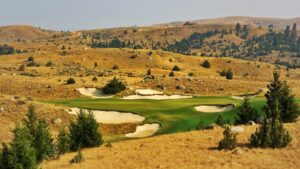
Montana: Rock Creek Cattle Company
Location: Deer Lodge; Established: 2008.
Bottom Line: Designed by Tom Doak, this course is routed across land that was once part of the historic Grant-Kohrs Ranch, an expansive property encompassing nearly 10 million acres of southwestern Montana. The track includes crisscrossing streams and native areas in one of the country’s foremost fly-fishing destinations, with a backdrop of the dramatic Flint Creek Mountain Range.

Nebraska: Sand Hills Golf Club
Location: Mullen; Established: 1995.
Bottom Line: Ben Crenshaw and Bill Coore took more than two years to trudge across more the 1,000 acres of the Nebraska Sandhills to decide on the final design for this track. By moving just 4,000 cubic yards of earth, and letting the winds shape the bunkers, the duo created what is undoubtedly the most natural golf course in America, and one of the best in the world.

Nevada: Shadow Creek Golf Course
Location: Las Vegas; Established: 1989.
Bottom Line: Tom Fazio designed, at a reported cost of $47 million, what he now calls “total site manipulation,” to fashion this course, carving rolling hills and canyons from the flat desert floor and pumping in plenty of water. The track makes golfers forget they are in the middle of the desert because of its 21,000 trees, all brought to the site and planted.
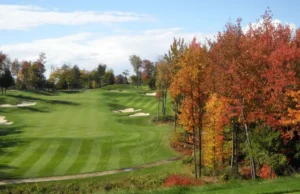
New Hampshire: Baker Hill Golf Club
Location: Newbury; Established: 2002
Bottom Line: This exclusive track was designed by Rees Jones and membership is kept down to a very low 225 people so the course is always available for play – if you’re a member. It’s set on 260 undulating and wooded acres between Wadleigh State Park and Lake Sunapee and is built in the classic style amid dramatic granite outcroppings.
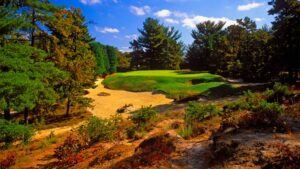
New Jersey: Pine Valley Golf Club
Location: Pine Valley; Established: 1918; Renovated: 2017.
Bottom Line: This course is considered the best in the country and one of the best in the world. Designers George Crump and H.S. Colt forged the track from the sandy pine barrens of southwest Jersey and made it extremely challenging even for the scratch golfer. It is known as the ultimate test of golf, and contains more classic golf holes than any other course anywhere.

New Mexico: Paa-Ko Ridge Golf Club
Location: Sandia Park; Established: 2000; Renovated 2005.
Bottom Line: There are 27 holes at this facility, designed by three-headed firm of Finger Dye Spann, but the original 18 are the course’s calling card. Holes are routed around and across arroyos, rocky outcrops and a variety of native vegetation, with the track set at between 6,500 and 7,000 feet in the foothills of the Sandia Mountains outside Albuquerque.

New York: Shinnecock Hills Golf Club
Location: Southampton; Established: 1891. Renovated 1894, 1931, 2012.
Bottom Line: Generally considered to be the earliest links in America, heavily remodeled by C.B. Macdonald, then replaced (except for three holes) by William S. Flynn in the early 1930s, this course is so sublime that its architecture hasn’t really been altered for nearly 50 years. Host of the U.S. Open four times (in 1896, 1986, 1995 and, most recently, 2018) the club is another of the five founding members of the United States Golf Association.

North Carolina: Pinehurst Resort & Country Club (Course No. 2)
Location: Pinehurst; Established: 1907; Restored: 1909, 2011, et al.
Bottom Line: This course was revnovated after opening as a nine-holer by Donald Ross and updated most recently by Bill Coore and Ben Crenshaw, who returned the track to its sandy character. No.2 has hosted the most single golf championships of any other course in the United States, including the 1999, 2005 and 2014 U.S. Opens. It is a true thinking-man’s course, demanding shot-creation on every swing. Off the tee, there are great lines for shot visualization but it can also trick players. The domed putting surfaces here are among the world’s most famous.

North Dakota: Hawktree Golf Club
Location: Bismarck; Established: 2000.
Bottom Line: The course, designed by Jim Engh, offers distinctive holes, and features sweeping elevation changes that are both unexpected and exciting. Natural hills and contours, brilliant coloration, plentiful wildlife and native grasses add mightily to the experience, as does the unique black coal slag used in its bunkers.

Ohio: Muirfield Village Golf Club
Location: Dublin; Established: 1974; Renovated: 2015, et al..
Bottom Line: The course is a dream-come-true for Jack Nicklaus, who teamed up with Desmond Muirhead to create the championship track that hosted the 1987 Ryder Cup and is the home of the annual Memorial Tournament on the PGA Tour. The challenge here asks players to overcome bold bunkering, water hazards galore, and narrow fairways that require pinpoint shots.
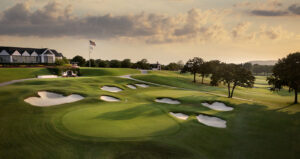
Oklahoma: Southern Hills Country Club (Championship Course)
Location: Tulsa; Established: 1936; Renovated: 2018
Bottom Line: This course is architect Perry Maxwell’s great achievement. Nearly every hole moves to the left or right, posing tee shots that demand conviction and execution. Architect Gil Hanse and crew rebuilt much of the course in 2018, in the process re-establishing Maxwell’s distinctive, gnarly edged bunkering. The course has played host to seven major championships.

Oregon: Bandon Dunes Golf Resort (Pacific Dunes)
Location: Bandon; Established: 2001
Bottom Line: The top-ranked course of the six at one of the world’s great golf destinations, this track was designed by Tom Doak. The course doesn’t feel like it was built as much as it was discovered, as rippling fairways remain just as they were found and natural bunkers line the landscape as they have for centuries. The course emerges from shore pines to spectacular 60-foot sand dunes. The secret here is Doak moved a lot of earth in some places to make it look like he moved very little.

Pennsylvania: Oakmont Country Club
Location: Oakmont; Established: 1903; Renovated: 2014.
Bottom Line: This brutal beauty was designed by club founder Henry Clay Frownes and is one of the best in the country. It has hosted 11 major tournaments, eight of which were the U.S. Open.
Famous for its church-pew bunkers, the track also has deep drainage ditches and ankle-deep rough and the game’s swiftest putting surfaces.
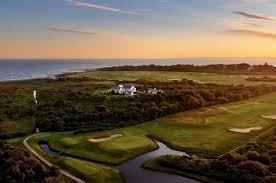
Rhode Island: Newport Country Club
Location: Newport; Established: 1893; Renovated: 1915, 1923, 2003, et al.
Bottom Line: This course is one of the five founding club members of the United States Golf Association and played host to the first ever U.S. Open in 1895. This course, which has been renovated by both Donald Ross and A.W. Tillinghast, has the look and feel of a seaside links. Undulating greens, tight fairways, rugged rough and a great mix of short and long holes is what this course a real challenge.

South Carolina: The Ocean Course
Location: Kiawah Island; Established: 1991; Renovated: 2002, 2011.
Bottom Line: This highly difficult track has the most seaside holes of any course in the Northern Hemisphere. Designed by Pete Dye and Alice Dye, the course has hosted many major tournaments, including the 2012 PGA Championship, the inaugural UBS Cup in 2001, and the 1991 Ryder Cup. Every hole is edged by sawgrass, every green has tricky slopes, and every bunker merges into bordering sand dunes.

South Dakota: Sutton Bay
Location: Sutton Bay; Established: 2003.
Bottom Line: The course was designed by Graham Marsh and sits above the spectacular landforms of the Missouri breaks and overlooks the massive expanse of water known as Lake Oahe.
This private, exclusive track can be authentically described as true inland links golf located on a parcel of land that provides some of the best views of any golf course in the world.

Tennessee: The Honors Course
Location: Ooltewah; Established: 1983; Renovated: 1988, 1999, 2008.
Bottom Line: Acres of tall, native-grass rough and terrifying greens perched atop bulkheads of rock are some of the features that mark this course as an example of Pete Dye’s all-or-nothing architecture style. It was designed to honor amateur golf and has hosted 18 amateur championships. There has never been a professional event of any kind held here.

Texas: Whispering Pines Golf Club
Location: Trinity; Established: 2000
Bottom Line: The course, designed by Chet Williams (whose pedigree included work with Jack Nicklaus) is situated on a spectacular 400-acre property featuring piney woods, creeks, lakes, natural dunes, and abundant wildlife.
It is the home of The Spirit International Amateur Golf Championship, a biennial world-class event featuring 20 countries from six continents, with each represented by their two best men and two best women amateur players.

Utah: Glenwild Golf Club
Location: Park City; Established: 2001
Bottom Line: This course, designed by Tom Fazio and set at an elevation of 7,000 feet, features a unique, natural layout that embraces the topography. It sits on a meadow valley north of Park City, offering invigorating vistas of the Wasatch Mountains. Fazio clustered holes together, positioned some holes along a couple of irrigation lakes and linked the lakes via a network of streams and cascading waterfalls.

Vermont: Ekwanok Country Club
Location: Manchester
Established: 1899.
Bottom Line: Site of the U.S. Amateur in 1914 (won by Francis Ouimet, who also won the U.S. Open in 1913), this course is another on our list that’s focused on amateur golf. The track was designed by Walter Travis and John Duncan Dunn and is nestled in a valley amid the Taconic Range mountains that loom over its historic routing.

Virginia: Kinloch Golf Club
Location: Manakin-Sabot; Established: 2001; Renovated 2016.
Bottom Line: This course has more double fairways posing options and alternate routes than nearly every other course on our list. It’s a beautiful parkland course set on 274 acres with a 70-acre lake as its centerpiece. Designer Lester George routed the track through hardwood and pine trees, with a natural look and minimal earth moving.

Washington: Sahalee Country Club (South/North)
Location: Sammamish; Established: 1969; Renovated: 1996.
Bottom Line: This course, originally designed by Ted Robinson and renovated by Rees Jones, was carved from a Pacific Northwest forest of cedar, spruce, fir and pine on the Sammamish Plateau. Its dominant theme has always been narrow fairways framed by towering trees that reach to the heavens. The track played host to the 1998 PGA Championship, the 2002 World Golf Championship, and the U.S. Senior Open in 2010.

West Virginia: Pikewood National Golf Club
Location: Morgantown; Established: 2004; Renovated: 2009.
Bottom Line: Mining company officers John Raese and Bob Gwynne bought this land and spent almost a decade creating this track. Every hole has been given a great deal of consideration and fit into the terrain, with gorgeous results. Sight lines are well thought-out, and trees have been felled to give views of the surrounding mountains.

Wisconsin: Whistling Straits (Straits)
Location: Haven; Established: 1998; Renovated: 2009, 2011.
Bottom Line: Pete Dye transformed a dead flat abandoned army air base along a two-mile stretch of Lake Michigan into an imitation Irish-style links course, with awesome dividends. He peppered his rugged fairways and windswept greens with 1,012 (at last count) bunkers, some as small as a pothole. The course was the site of the PGA Championship in 2004, 2010 and 2015 and will host the 2020 Ryder Cup.

Wyoming: Snake River Sporting Club
Location: Jackson; Established: 2006; Renovated: 2014.
Bottom Line: Set within what was once a massive cattle ranch and designed by Tom Weiskopf, this course begins at the base of a mountain with the natural sounds of swaying cottonwoods and rushing Snake River enveloping the golfer. The river meanders along the course and millions of acres of national forest stretch into the distance.


